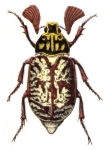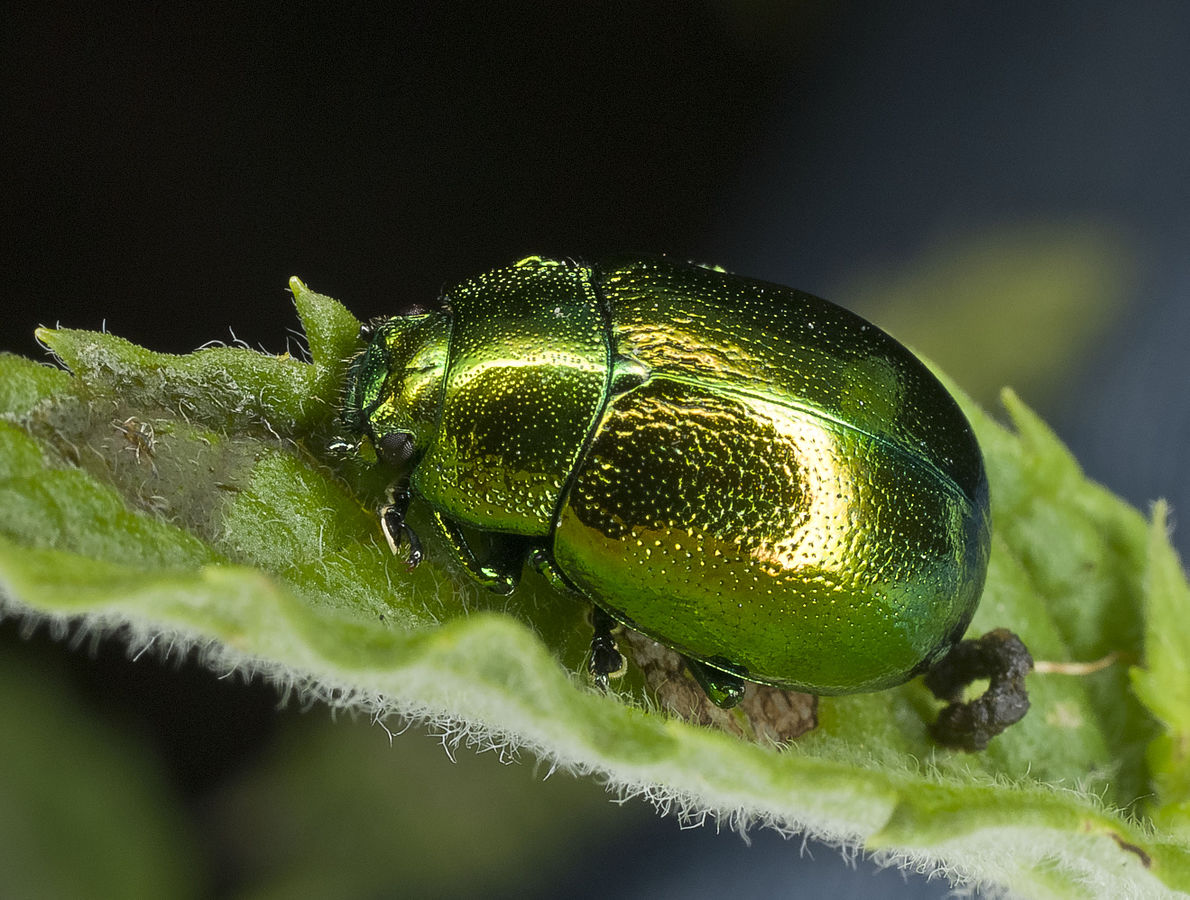|
Description / Habitats / Flora / Vertebrates / Insects / Invertebrates / What's that Bug? Home / Nestos Delta / Bibliography / About this site / Links / Contents / Galleries ____________________________________________________________________________ |
|
__________________________________________________________________________________________________________ THE LEAF AND SEED BEETLES (COL., CHRYSOMELIDAE) OF THÁSOS
Chrysolina herbacea (c) pjt56 The leaf and seed beetles comprise one of the largest beetle families in Europe, with about 2000 species known so far. As their name implies, they are phytophagous and feed almost exclusively on various structures of higher plants (at least in Europe where very few species are known to feed on mosses, ferns, etc.), including deciduous trees and shrubs but not conifers. Recently several taxonomic changes have been made regarding the Chrysomelidae and the seed beetles (Bruchinae) are now incorporated whereas previously they were classified in their own Family but generally regarded to be closely related to the weevils (Curculionoidea). These revisions have also led to the separation of the Orsodacnidae as a separate Family, having previously been included within the Chrysomelidae - the sole member known from Thásos (Orsodacne humeralis) is included here for convenience. Leaf beetles are generally inconspicuous and not likely to attract attention from the casual visitor but the striking, metallic emerald green Chrysolina herbacea on various mint species or its deep blue congener C. vernalis are worth looking out for. Chrysomelids are more likely to be noticed as agricultural or garden pests or as defoliators of shrubs, such as willow and alder. Along the beach in Keramoti in May 1995 hundreds of Colorado beetles Leptinotarsa decemlineata, a potentially devastating pest of potato crops, were grounded in strong winds (along with thousands of other beetles), but this species has not so far been reported from Thásos. Gruev (1990) discussed the known distribution of several chrysomelid Families in Greece and also listed (Gruev 2005) the 434 chrysomelid species recorded from Greece at that time (hence excluding the Bruchinae). Aydin & Kismali (1990) reviewed the species of Clytrinae in the Aegean region of Turkey and Turanli et. al. (2002) reported on surveys of the chrysomelid sub-Families Criocerinae and Crytocephalinae in the same area. The scientific literature includes papers on chrysomelids in Santorini, Rhodes and Crete (Rozner & Rozner 2014) but I'm not aware of any published studies from the North Aegean to put Thásos into context. The Bulgarian surveys of 1942 and 1943 (Karnozickij 1959) present the first reports of leaf and seed beetles on the island, recording sixteen species, ten of which have not been seen since. Given the advances in taxonomy over the last 50 years it's not possible to say if these species are correctly named in line with current knowledge but all ten are known from Greece and likely to occur on Thásos. Gruev (1990) adds a further seven species (mainly from specimens held in the Natural History Museum, London) and Borowiec & Anton (1993) add the seed beetle Spermophagus calystegiae recorded in 1990. Uhman (1952) mentions that the distinctive Dicladispa testacea occurs on Thásos, probably based on the surveys of the 1940s. As much of my own collecting has been focused on weevils I have been able to record a wide range of chrysomelids during my own surveys. To date, 44 species have been identified, including 37 (asterisked in the Checklist below) which appear to be new to the island fauna. This gives a total of 61 species of Chrysomelidae and Orsodacnidae currently known from Thásos. Identification of leaf beetles in Greece is possible using Warchalowski (2003). This has comprehensive coverage of all European Chrysomelidae up to that point (and therefore excluding the seed beetles) and usually works well. There are some errors along the way that can lead to dead-ends but there are several useful websites with good images, such as Lech Borowiec's wonderful Leaf Beetles of Europe and the Mediterranean Sub-Region, to check that you are on the right track. Unfortunately nothing comparable exists for the Bruchinae as yet. Lompe's Käfer Europas can provide a good starting place, as can Hoffmann (1945), but both are geographically limited and I could only identify about half of the bruchids I collected using these keys. Yus-Ramos (2013) covers the distinctive species with long and strongly serrated antennae in the genus Serratobruchidius.
CHECKLIST Chrysomelidae: Alticinae
Altica oleracea (Linnaeus, 1758) Chaetocnema confusa (Boheman, 1851) * Epitrix pubescens (Koch, J.D.W., 1803) *
Longitarsus melanocephalus (De Geer, 1775) Phyllotreta cruciferae (Goeze, 1777) Podagrica fuscicornis (Linnaeus, 1767)
Psylliodes circumdata (Redtenbacher, 1842)
Bruchinae
Bruchidius bimaculatus (Olivier, 1795 Serratobruchidius quinqueguttatus (Olivier, 1795) *
Spermophagus calystegiae (Lukjanovitsh & Ter-Minassian, 1957)
Cassidinae Pilemostoma fastuosa (Schaller, 1783)
Chrysomelinae Phaedon pyritosus (Rossi, 1792) Prasocuris junci (Brahm, 1790) *
Clythrinae
Clytra atraphaxidis (Pallas, 1773)
*
Smaragdina limbata Steven, 1806
*
Criocerinae
Crioceris duodecimpunctata (Linnaeus, 1758)
*
Cryptocephalinae
Cryptocephalus anticus Suffrian, 1848
* Eumolpinae
Pachnephorus tessellatus (Duftschmid, 1825)
*
Galerucinae
Galeruca interrupta Illiger, 1802
Phyllobrotica adusta (Creutzer, 1799)
* Orsodacne humeralis Latreille, 1804 *
Unconfirmed records: A specimen of Galerucella from maquis on the outskirts of Thassos Town in May 1997 keys to calmariensis (Linnaeus, 1767) but doesn't look quite right (scutellum, fore coxae, pro- & mesosternum orange; metasternum & sternites black) and its host, purple loosestrife Lythrum salicaria, is not known from Thásos and would not be expected in this habitat.
REFERENCES
Aydin, E. & Kismali, S. 1990. Faunistical studies on the Clytrinae (Coleoptera, Chrysomelidae) in the Aegean Region. Türk. entomol. derg., 14: 23-35.
Borowiec, L. & Anton, K.W. 1993. Materials to the knowledge of seed beetles of the Mediterranean Subregion (Coleoptera: Bruchidae). Ann. Upp. Sil. Mus., Entomology, 4: 99-152.
Gavrilović,
B.D. & Ćurčić, S.B. 2011. Diversity of species of the family
Chrysomelidae (Insecta, Coleoptera) in Serbia, with an overview of
previous researches. Acta zoologica
Gruev, B. 1990. The geographic distribution of Lamprosomatinae, Eumolpinae, Chrysomelinae, Alticinae, Hispinae and Cassidinae in Greece (Coleoptera, Chrysomelidae). Dtsch. Entomol. Z., 37: 289-359.
Gruev, B.A. 2005. A comparative list of the leaf beetles of the Balkan countries (Coleoptera: Chrysomelidae). Animalia, 41: 23-46.
Hoffmann, A.1945. Coléoptčres Bruchides et Anthribides. Faune de France, Vol. XLIV. P. Lechevalier, Paris.
Karnozickij, N. 1959. Materialien zur Koleopteren-Fauna der Agäischen Küste und Insel Thasos. Izv. zool. Inst. Sof., 8: 237-253.
Rozner, I. & Rozner, G. 2014. Data to the leaf-beetle fauna of Greece (Coleoptera: Chrysomelidae). Natura Somogyiensis, 24: 81-98.
Turanli, F., Kaya, F. & Kasmali, S. 2002. Ege Bölgesi'nde bulunan Criocerinae ve Cryptocephalinae (Coleoptera: Chrysomelidae) altfamilyalarına ait türler üzerinde faunistik araştırmalar. Turk. entomol.derg., 26: 301-316.
Uhman, E. 1952. Austral-Asiatische Hispinae (9. Teil) (Col.). Dicladispa-Arten und Dicladispa occator (Brulle). Treubia (Archipel-Bogor, Java), 21: 231-239.
Warchalowski, A., 2003. Chrysomelidae, the leaf beetles of Europe and the Mediterranean area. Natura optima dux Foundation.
Yus-Ramos, R. 2013. Serratobruchidius, un género nuevo de Bruchidiini para los Bruchidius Schilsky (s.l.) del grupo serraticornis (Coleoptera: Bruchidae). Boletín de la Sociedad Entomológica Aragonesa, 52: 17-21.
|

















